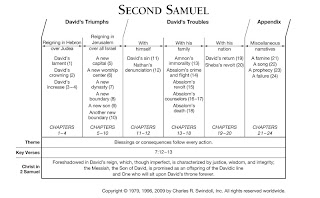THE SECOND BOOK OF
SAMUEL
NAME:
This book is the continuation of the first book of Samuel,
which accounts for the fact that it is called Samuel, though it does not relate
to the priest and prophet by this name. The traditional view is that Samuel
wrote the first 24 chapters of First Samuel, and the remaining part of that
book and the records of the second book were written by the prophets Nathan and
Gad.
THEME:
This Book records the events of David’s reign and it marks
the restoration of order and prosperity in Israel through the enthroning of GOD’S
anointed King, chosen as God had ordained from the royal tribe of Judah. Saul
who had failed and had been rejected by God was of the tribe of Benjamin. In
the choice of David, GOD set up the royal family, through whom the MESSIAH
should be given to the world (7:8-17) Acts (13:22-23). The book is a record of notable
achievement s by the great King; of sins by both King and people; of GOD’S
judgement; of repentance, forgiveness, and restorations; of triumphant faith
and righteousness. Among the important events was the establishment of Israel’s
political center in Jerusalem and her religious center in Zion (5:6-12)
OUTLINE:
Historically, the book may be divided into four chief sections;
1) From the death of Saul to the anointing of David as King
of Judah (1:1-1:27)
2) From the setting up of David’s Reign in Hebron to his
establishment as King over Israel (2:1-5:25)
3) From the establishment of the capitol at Jerusalem to the
rebellion of Absalom to the purchase of the temple site (15:1-24:25)


.jpg)


.jpg)

.jpg)

.gif)
.jpg)
.jpg)
.jpg)